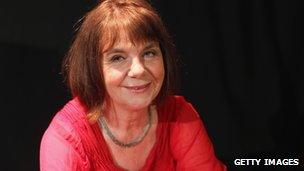Edward Lear: Two hundred years of nonsense
- Published

Lear's Owl and the Pussycat has been translated into languages as diverse as Bengali, Polish, Cree and Amharic
Poet Edward Lear was a genius at writing "nonsense" verse. But the author of surreal limericks was also a serious travel writer, zoological illustrator and landscape painter. Had he been alive today he would have been 200 years old, alongside his great contemporary Charles Dickens.
Children's author and laureate Julia Donaldson - writer of The Gruffalo - is among Lear's many enthusiasts and has written a sequel to his most celebrated work The Owl and the Pussycat to mark the anniversary.
Lear's poem tells the story of two animals who go to sea in a beautiful pea green boat. The elegant fowl serenades his feline love to the sounds of "a small guitar". After getting a ring from the nose of "a piggy-wig" they are married next day by the turkey on the hill.
This romantic and touching little poem has been set to music by Igor Stravinsky and Laurie Anderson among others. It has also been translated into languages as diverse as Bengali and Polish, Cree and Amharic.
Perhaps surprisingly, however, Lear's career began not with words but with pictures. He jokes that he "began to draw for bread and cheese' at about the age of 15.
He soon became a commercial artist. By the age of 18 he received permission to draw from life the parrots of London Zoo and, from 1830 to1832, he published in total 42 lithographs of parrots.
Lear's lithographs were so successful that in 1832 the president of London Zoo, Lord Stanley, hired Lear to draw the menagerie of birds and mammals at Knowsley Hall, near Liverpool.
It was there that Lear's gift for light verse made him a huge success with the family of the Earl of Derby.

Julia Donaldson says she finds Lear's mix of sadness and humour 'very appealing'
"He started writing verse for this man's great grandchildren to entertain them," says Donaldson. "It was just meant to be a sideline, I think the serious business of his life was his art."
The sideline made Lear famous. In 1846 he published A Book of Nonsense. It contains some of his best-loved limericks such as: "There was an old man with a beard, who said, 'It is just as I feared! Two owls and a hen, four larks and a wren, have built their nests in my beard!'"
Donaldson is a great fan of Lear's "nonsense words, the wonderful words such as runcible and scroobious that children and adults love".
Although accomplished and successful, Lear's life was marked by much unhappiness. The bad times started early on. Lear was the 20th of 21 children. His father was a stockbroker but when the boy Lear was four his father went bankrupt and - like Charles Dickens's father - seems to have ended up in a debtor's prison.
At the time the young Lear left his parents' home with his eldest sister, Ann, who was 21 years older than him.
"Ever since he was a child he had fits of depression," says Donaldson.
One day when Lear was around seven years old, his father took him to a field near Highgate in north London. He saw some clowns, and a band playing. Afterwards he went home and cried "half the night" - as he recollected years later.
Donaldson says "he realised, at an early age, that happiness and beauty were transient".
Lear's own word for it was "morbidness" and it may explain what Donaldson calls "that mixture of happiness and sadness in his work".
In Lear you find humour but also pathos. "Creatures such as the Dong with the Luminous Nose and the little birds in the poem, Callico Pie, that never come back. There is a kind of sadness mixed in with the humour, which is very appealing," says Donaldson.
In The Owl and Pussycat, however, pathos is held at bay, just.
Of her sequel, Donaldson says: "I cannot tell you everything but they go off in search of that very ring that they got married with - it gets stolen right at the beginning of my story by a crow - and they sail away in a beautiful blue balloon."
Surely Lear would have approved.
<italic>Julia Donaldson spoke to </italic> <link> <caption>Newshour </caption> <url href="http://www.bbcworldservice.com/newshour" platform="highweb"/> </link> <italic>on the BBC World Service.</italic>
- Published12 October 2010
- Published12 May 2012